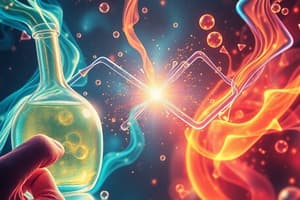Podcast
Questions and Answers
Match the factor affecting reaction rates with its description:
Match the factor affecting reaction rates with its description:
Chemical Nature of the Reacting Substances = Identity of reactants affecting reaction rate State of Subdivision of the Reactants = Effect of surface area on reaction rate Temperature = Impact of increased kinetic energy on reaction rate Concentration = Relation between reactant concentration and reaction rate
Match the impact on reaction rates with the correct factor:
Match the impact on reaction rates with the correct factor:
Higher reactivity of substances = Chemical Nature of the Reacting Substances Increased surface area of reactants = State of Subdivision of the Reactants More collisions due to higher concentration = Concentration Overcoming activation energy more easily = Temperature
Match the industrial application with the role of catalysts:
Match the industrial application with the role of catalysts:
Production of fertilizers, pharmaceuticals, and petroleum products = Essential role in increasing reaction rate Refining of petroleum products = Utilization to speed up reactions without affecting equilibrium position Production of pharmaceuticals = Use in providing an alternative pathway for reactions Production of fertilizers = Significantly changing reaction rates without altering thermodynamics
Match the gas-phase reactions factor with its influence on reaction rates:
Match the gas-phase reactions factor with its influence on reaction rates:
Match the description with the factor affecting reaction rates:
Match the description with the factor affecting reaction rates:
Flashcards are hidden until you start studying
Study Notes
Chemistry: Rate of Reaction
Introduction
Chemical reactions occur when molecules collide, and undergo a chemical transformation. These reactions exhibit a wide range of rates, which depend on several factors. The rate of a chemical reaction is defined as the change in the concentration of one of its reactants per unit time. In this article, we will discuss the factors that affect the rate of chemical reactions, focusing on the concepts of activation energy and catalysts.
Activation Energy
The rate of a chemical reaction depends on the activation energy required for the reaction to proceed. Activation energy is the minimum amount of energy needed for a reaction to proceed in the forward direction. It is a barrier that must be overcome for the reaction to occur. This activation energy is provided by the kinetic energy of the reacting molecules.
The higher the activation energy, the fewer collisions will have the required energy to overcome the barrier, and therefore the slower the reaction rate. Conversely, if the activation energy is lower, more collisions will have the required energy to overcome the barrier, and the reaction rate will be faster.
Catalysts
A catalyst is a substance that increases the rate of a chemical reaction by lowering the activation energy without itself being consumed by the reaction. Catalysts provide an alternative pathway or mechanism for the reaction to follow, which requires less energy to overcome the activation barrier.
Catalysts work by providing an alternative pathway for the reaction, which allows the reaction to proceed more easily and quickly. They do not change the thermodynamics of the reaction, meaning they do not affect the equilibrium position, but they can significantly change the reaction rate.
The use of catalysts in chemical reactions is essential in various industries, including the production of fertilizers, the production of pharmaceuticals, and the refining of petroleum products.
Factors Affecting Reaction Rates
-
Chemical Nature of the Reacting Substances: The identity of the reactants can significantly affect the rate of a reaction. Reactions involving substances with higher reactivity will generally proceed more rapidly than those involving less reactive substances.
-
State of Subdivision of the Reactants: Reactions involving solids or gases occur more rapidly when the surface area of the reactants is increased, as it provides more opportunities for collisions between reactant molecules.
-
Temperature: The rate of a chemical reaction increases with temperature. This is because higher temperatures provide the reacting molecules with more kinetic energy, which can overcome the activation energy barrier more easily.
-
Concentration: The rate of a reaction generally increases with an increase in the concentration of the reactants. This is because increasing the concentration increases the likelihood of collisions between reactant molecules.
-
Pressure: In gas-phase reactions, the rate of a reaction increases with an increase in pressure. This is because higher pressures increase the concentration of reactant molecules, leading to more frequent collisions.
Conclusion
The rate of a chemical reaction is a critical factor in understanding the behavior of chemical systems. It is influenced by several factors, including the chemical nature of the reactants, their state of subdivision, temperature, concentration, and the presence of catalysts. Understanding these factors can help us predict and control the rates of chemical reactions, which is essential in various industrial and environmental applications.
Studying That Suits You
Use AI to generate personalized quizzes and flashcards to suit your learning preferences.




